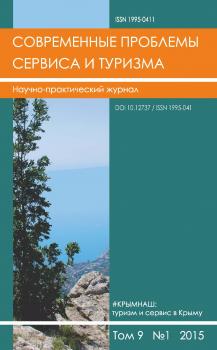Geo-cultural regional policy is associated with the actualization of the real identity of communities, people and events that can convert and transform the real image of the city. It should be focused on people and not on tangible or intangible objects. This is its essential difference from traditional regional policy. Geo-cultural branding of an area is not a traditional branding area that exists in western branding and marketing formats and is now developing on Russian soil. This activity is related to the cultivation areas of images, which are important for the cohesion of territorial communities. It can be a non-profit or commercial, but, anyway, the main purpose of geo-cultural branding cannot be initially commercial, it is focused not on profit but on the development of the identity of the city (and wider - regional) communities and the events that actualize the image of the city. At the end of XX- the beginning XXI centuries the concept of genius loci has become part of popular culture, one of the tools for development of tourism and marketing of areas, used in the protection and promotion of cultural heritage. As part of humanitarian geography the concept of "genius loci" is semantically correlated with the notions of cultural landscape as an object of heritage, local (spatial) myth, symbolic topography, geographical image. Particularly productive this notion in research on literature, geography, geography and the geography of aesthetic art, landscape architecture and garden art. Characteristics of image resources of cities and territories in the context of geo-cultural branding should include an analysis of the possibilities of using space imagery of geniuses and specific representations of these images within geocultural regional policy.
geoculture, geo-cultural area branding, image resources, local myth, image of the territory, image and geographical development, territorial identity, genius loci.
Геокультурная региональная политика и геокультурный брендинг территории: соотношение понятий. Геокультурная региональная политика связана с актуализацией идентичности реальных сообществ, с людьми и событиями, которые могут преобразовать и трансформировать реальный облик города. Она должна быть направлена на людей, а не на материальные или нематериальные объекты. В этом ее существенное отличие от традиционной региональной политики. В рамках геокультурной региональной политики можно говорить и о разработках геокультурных стратегий территорий и городов.
Геокультурная стратегия территории - система долговременных плановых мероприятий, направленная на учёт, эффективное использование и развитие геокультурной специфики и уникальности территории (культурные ландшафты, географические образы, локальные мифы, региональные идентичности). В настоящее время ни одна российская территория не имеет собственной геокультурной стратегии. Уникальная геокультура определённой территории - фундамент её успешного культурного, социального и экономического развития. Осознание собственной геокультурной уникальности и учёт геокультурной специфики
1. Antsiferov N. P. Dusha Peterburga. Peterburg Dostoevskogo. ВуГ i mif Peterburga [The Soul of St. Petersburg. Dostoevsky´s Petersburg. True story and the myth of St. Petersburg]. Reprint. M.: Kniga, 1991. 227 p.
2. Vail´ P. Genii mesta [Genius loci]. M.: KoLibri, 2007. 488 p.
3. Vedenin lu.A. Literaturnye landshafty как ob´ekt naslediia [Literary landscapes as heritage sites] // Geografiia iskusstva. Vyp. IV. 2005. pp. 10-26.
4. Zamiatin D. N. Identichnost´ i territorija: gumanitarno-geograficheskie podhody i diskursy [Identity and territory: the humanitarian and the geographical approaches and discourses] / V sb. «Identichnost´ как predmet politicheskogo analiza». M.: IMEMO RAN, 2011. p. 186-203.
5. Zamiatin D. N. Lokal´nye istorii i metodika modelirovaniia gumanitarno-geograficheskogo obraza goroda [Local history and technique of modeling of humanitarian and geographic image of the city] // Gumanitarnaia geografiia. Nauchnyi i kul´turno-prosvetitel´skii al´manakh. Vyp. 2. 2005. pp. 276-323.
6. Zamiatin D. N. Lokal´nye mify: Modern i geograficheskoe voobrazhenie [Local myths: Modern and geographical imagination] / Vsb. «Literatura Urala: istorija i sovremennost´. Ekaterinburg: lzd-vo Ural, un-ta, 2008. p. 8-44.
7. Zamiatin D. N. Russkaja usad´ba: landshaft i obraz [Russian estate: landscape and image] //Vestnik Evrazii. 2006. № 1. p.70-91.
8. Zamiatin D. N., Zamiatina N. lu. Genij mesta i gorod: varianty vzaimodejstvija [The genius of the place and the city: the interaction options] //Vestnik Evrazii. 2007. № 1. p. 62-87.
9. Zamiatina N. lu. Obraz goroda i iskusstvo [The image of the city and art] // Geografiia iskusstva. Vyp. IV 2005. pp. 26-43.
10. Kotler F., Asplund K., Rein I., Khaider D. Marketing mest. Privlechenie investitsii, predpriiatii, zhitelei i turistov v goroda, kommuny, regiony i strany Evropy [Marketing of Places. Attracting investments, businesses, residents and tourists in cities, municipalities, regions and countries in Europe]. SPb.: Stokgol´mskaia shkola ekonomiki v Sankt-Peterburge, 2005. 384 p.
11. Marburg Borisa Pasternaka [Boris Pasternak´s Marburg] /Sost. E. L Kudriavtseva. M.: Russkii put´, 2001. 258 p.
12. Rakhmatullin R. Nebo nad Moskvoi. Vtoroi lerusalim Mikhaila Bulgakova [The sky above Moscow. Second Jerusalem of Mikhail Bulgakov] // Ex libris NG. Knizhnoe obozrenie к «Nezavisimoi gazete». 24.05.2001. p. 3.
13. Shchukin V. Mif dvorianskogo gnezda: Geokul´turologicheskoe issledovanie po russkoi klassicheskoi literature [The myth of the noble nest: Geo Cultural Studies of Russian classical literature].- Krakov: Izdatel´stvo lagellon-skogo universiteta, 1997. 315 p.





